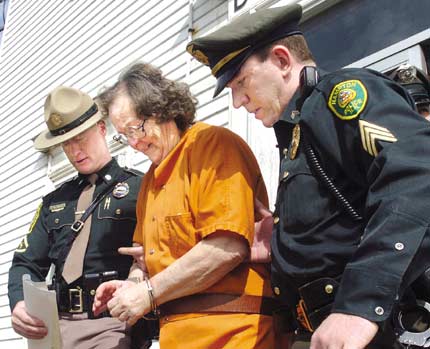Elder Abuse More Common Among Spouses, Statistics Show
By Lara Bricker
Hampton Union, Tuesday, March 30, 2004

[Staff photo by Sarah Zenewicz]
HAMPTON -- The physical abuse of an elderly person is not an uncommon situation in New Hampshire or anywhere across the country.
However, the relationship recently revealed between two Hampton sisters - 85-year-old Alice Keyho and her alleged abuser, her 74-year-old sister Helen Garland - is not common. Elder abuse by siblings accounts for only 1.8 percent of elder abuse cases reported nationwide, according to Sara Aravanis, director of the National Center on Elder Abuse in Washington, D.C. The perpetrator in cases of elder abuse is most often a spouse, accounting for 30.2 percent of cases, or an adult child of the victim, accounting for 17.6 percent of the cases nationwide.
Elder abuse among siblings ranks at the bottom of the list in terms of frequency, surpassed in its rarity only by elder abuse committed by tenants or a stranger, according to statistics from the National Center on Elder Abuse.
When contacted by Seacoast Newspapers on Monday, the Clearinghouse on Abuse and Neglect of the Elderly - a nationwide information-gathering organization in Maryland - could not identify any cases in which an elderly sibling assaulted another elderly sibling.
"Sibling assaults are unusual, given that it's not a common pattern of cohabitation," said David Finkelhor, director of the Crimes Against Children Research Center and co-director of the Family Research Laboratory at the University of New Hampshire.
The practice of elderly siblings living together was previously more commonplace, he said, but now is more rare.
New Hampshire Trends
The number of elder abuse cases in New Hampshire is on the rise, according to Doug McNutt, acting director of the state Division of Elderly and Adult Services. The agency, which handles all adult cases of abuse and neglect, has seen more elderly victims over the past year, he said. Also, the awareness of elder abuse is rising owing to several recent high-profile cases.
Of the 1,873 cases of abuse, neglect and exploitation that were reported to the state in 2003, McNutt said 437 were of victims between the ages of 80 and 89. Victims in the 70-79 age range made up 436 of the cases, and those in the 60-69 age range made up 250 of the 1,873 state total.
Older victims are the most vulnerable, said McNutt, and are less likely to report the abuse.
"If you are dependent on this person to come and do things for you, you don't know that you have an option but to put up with it, because you don't know who else is going to take care of you," he explained.
State law includes special provisions for cases in which an alleged abuser takes advantage of a victim's age and or disability. Senior Assistant Attorney General Michael Delaney, who is prosecuting the case against Garland, said the state is using an enhanced penalty allowed by statue for its first-degree assault charges against Garland. Prosecutors allege that she committed the acts with the "intention" of taking advantage of her sister's age or physical disability. Under the enhancement, a maximum jail term of 10 to 30 years is allowed, rather than the 7½ to 15 years the charge normally carries.
Elder abuse also includes domestic abuse, McNutt said.
"It's the one that people forget about - domestic violence doesn't disappear with age," he said, adding that there are difficulties in the reporting of elder abuse in general. "I don't think people understand what to do about elder abuse the same way they do child abuse. There's been more publicity about child abuse."
According to the state, elder abuse falls into four categories: Physical and verbal abuse, self-neglect, neglect, and exploitation, which is usually financial. Of the 1,873 cases reported in 2003, 813 were self-neglect; 297 were emotional abuse; 222 were physical abuse; 203 were exploitation; and 45 were sexual abuse. These figures include all victims over the age of 18, McNutt said.
Victims of financial exploitation also may be hesitant to report the abuse.
"Sometimes with regard to the financial cases, the seniors might be sort of embarrassed that they were taken advantage of," said McNutt.
